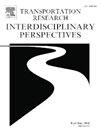Decision support tools for effective bus fleet electrification: Replacement factors and fleet size prediction
IF 3.9
Q2 TRANSPORTATION
Transportation Research Interdisciplinary Perspectives
Pub Date : 2024-11-01
DOI:10.1016/j.trip.2024.101267
引用次数: 0
Abstract
The electrification of public transit systems represents a crucial strategy for advancing sustainable urban mobility. Thus, the development of efficient charging infrastructure and the optimization of fleet size emerge as major challenges for transit agencies. Switching from diesel buses to electric buses (Ebuses) will require increasing the fleet size to accommodate the limited range of Ebuses and the significant idle time required for charging. This study develops prediction models to estimate the required Ebus fleet size to maintain same transit route services for the case of overnight depot charging, using data from Ebuses operating in the City of Toronto. The analysis reveals that Ebuses equipped with diesel auxiliary heaters are less sensitive to temperature fluctuations compared to battery-heated buses. Thus, the required replacement factor, indicating the additional fleet needed to switch from diesel to Ebuses, varies depending on the heating system. Specifically, diesel-heated buses require a lower replacement factor (1.3) compared to battery-heated buses (1.4), with winter conditions exacerbating this disparity. Furthermore, the study employs vehicular, operational, route, and external variables to develop the prediction models. Additionally, SHAP analysis is utilized to interpret the machine learning models and evaluate the influence of the inputs on the required fleet size. The results show that the total distance traveled, and the average temperature are the primary factors affecting the fleet size for Ebuses using their batteries for heating, whereas the total distance traveled, and the average bus speed are the primary factors affecting the fleet size for Ebuses with diesel auxiliary heaters.
有效实现公交车队电气化的决策支持工具:替换系数和车队规模预测
公共交通系统电气化是推进可持续城市交通的重要战略。因此,开发高效的充电基础设施和优化车队规模成为公交公司面临的主要挑战。从柴油公交车转向电动公交车(Ebuses)需要扩大车队规模,以适应 Ebuses 有限的续航能力和充电所需的大量空闲时间。本研究利用在多伦多市运营的电动巴士的数据,建立了预测模型,以估算在过夜车库充电的情况下,维持相同公交线路服务所需的电动巴士车队规模。分析表明,与电池加热巴士相比,配备柴油辅助加热器的电动巴士对温度波动的敏感性较低。因此,所需的更换系数(即从柴油巴士更换为电动巴士所需的额外车队)因加热系统而异。具体而言,柴油加热公交车所需的更换系数(1.3)低于电池加热公交车(1.4),而冬季条件会加剧这种差异。此外,该研究还采用了车辆、运营、路线和外部变量来开发预测模型。此外,还利用 SHAP 分析来解释机器学习模型,并评估输入对所需车队规模的影响。结果表明,总行驶距离和平均温度是影响使用电池加热的电动公交车车队规模的主要因素,而总行驶距离和平均公交速度则是影响使用柴油辅助加热器的电动公交车车队规模的主要因素。
本文章由计算机程序翻译,如有差异,请以英文原文为准。
求助全文
约1分钟内获得全文
求助全文
来源期刊

Transportation Research Interdisciplinary Perspectives
Engineering-Automotive Engineering
CiteScore
12.90
自引率
0.00%
发文量
185
审稿时长
22 weeks
 求助内容:
求助内容: 应助结果提醒方式:
应助结果提醒方式:


